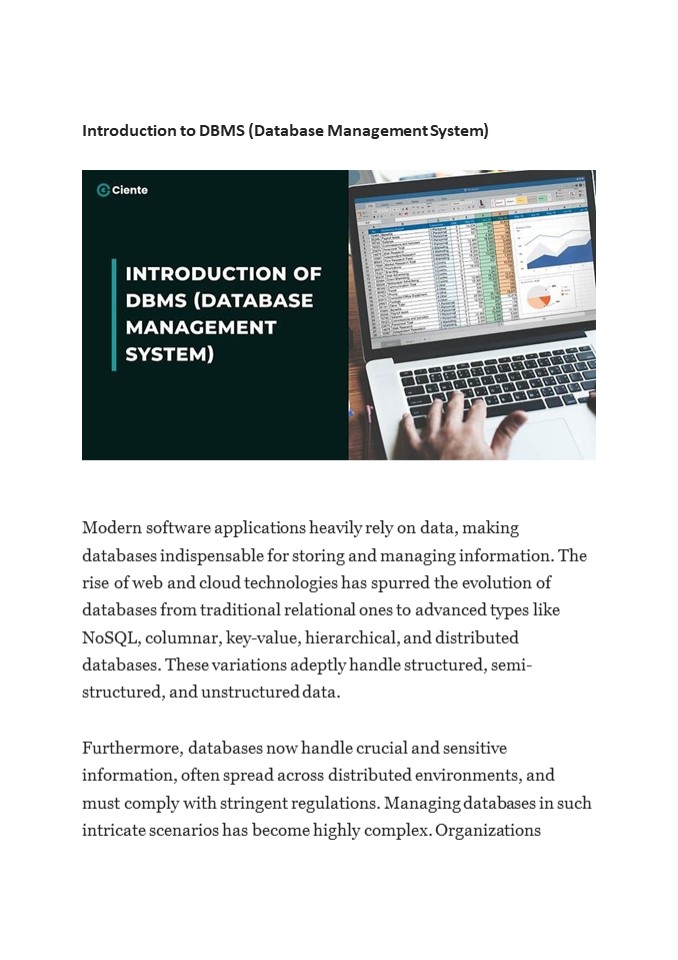Introduction to DBMS (Database Management System) - PowerPoint PPT Presentation
Title:
Introduction to DBMS (Database Management System)
Description:
Modern software applications heavily rely on data, making databases indispensable for storing and managing information. – PowerPoint PPT presentation
Number of Views:2
Title: Introduction to DBMS (Database Management System)
1
Introduction to DBMS (Database Management System)
Modern software applications heavily rely on
data, making databases indispensable for storing
and managing information. The rise of web and
cloud technologies has spurred the evolution of
databases from traditional relational ones to
advanced types like NoSQL, columnar, key-value,
hierarchical, and distributed databases. These
variations adeptly handle structured, semi-
structured, and unstructured data. Furthermore,
databases now handle crucial and sensitive
information, often spread across distributed
environments, and must comply with stringent
regulations. Managing databases in such
intricate scenarios has become highly complex.
Organizations
2
- necessitate robust, secure, and user-friendly
tools to navigate this complexity effectively. - This is where database management systems step
in, providing a comprehensive platform for
managing databases in diverse and demanding
contexts. - What is DBMS?
- A Database Management System (DBMS) is
specialized software crafted to systematically
manage and structure data. It empowers users to
create, edit, and retrieve information within a
database, while also overseeing security
measures and access controls for the stored
data. - Characteristics of DBMS
- contains automatic backup and recovery
procedures. - It can reduce the complex relationship between
data. - It is used to provide security of data.
- It uses a digital repository established on a
server to store and manage the information.
3
- Examples of DBMS
- Oracle Oracle Database stands as a premium
commercial relational database management
system, leveraging enterprise- grade technology
equipped with a comprehensive set of features
from the get-go. It offers the flexibility of
deployment, allowing storage either in the cloud
or on-premises environments. - MySQL MySQL is a widely utilized relational
database management system, often paired with
open-source content management systems and
prominent platforms such as Facebook, Twitter,
and YouTube. - SQL Server Created by Microsoft, SQL Server is a
relational database management system that
operates on the foundation of structured query
language (SQL), a standardized programming
language enabling database administrators to
efficiently manage databases and retrieve data. - Conclusion
- In large organizations, databases house crucial
records intertwined with numerous other
datasets, their complexity increasing with user
numbers. Consequently, organizations must
vigilantly monitor, fine- tune, and enhance
their databases to maintain high performance
levels. Several pivotal factors affect database
performance, such as system resources, workload,
throughput, contention, and optimization.
Without a dedicated database monitoring tool,
accurately gauging the impact of these factors on
database
4
performance becomes challenging. This
understanding is vital, as it directly
influences both application and business
performance in the long run. About Ciente
? With Ciente, business leaders stay abreast of
tech news and market insights that help them
level up now, Technology spending is increasing,
but so is buyers remorse. We are here to change
that. Founded on truth, accuracy, and tech
prowess, Ciente is your go-to periodical for
effective decision-making. Our comprehensive
editorial coverage, market analysis, and tech
insights empower you to make smarter decisions to
fuel growth and innovation across your
enterprise. Let us help you navigate the rapidly
evolving world of technology and turn it to your
advantage. Explore More for more such blog
posts. Follow us for the latest content updates.































